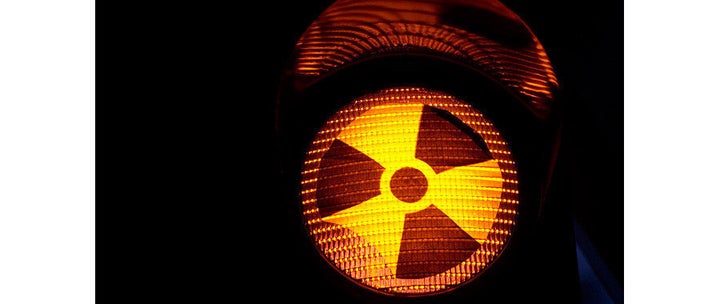
...or, "How to spend $6 billion, create 600 jobs, and prop up the most unproductive sector of the military industrial complex for another generation."
Despite President Obama's campaign rhetoric of a world without nuclear weapons, despite the recent catastrophe at Japan's Fukushima complex, and despite the new START nuclear arms control treaty between the U.S. and Russia last February, it seems the desire among our leaders for nuclear power and nuclear weaponry remains as strong today as it was at the height of the Cold War. What's just as disturbing, though, is the disregard our government shows for any input from its citizenry -- pro or con.
In a recent Santa Fe Radio Café interview with Greg Mello, co-founder of the Los Alamos Study Group, an Albuquerque-based watchdog organization that monitors the goings-on at New Mexico's Los Alamos National Labs, this sober, fact-loving, almost phlegmatic "Joe Friday" of an activist outlined very clearly both the potential gains and losses (and for whom) of the National Nuclear Security Administration's plans for a new Chemistry and Metallurgy Research Replacement (CMRR) facility at LANL, before going completely off character to point out the utter neglect that the Department of Energy (among many other government agencies) has for any due process.
Mello said that the main purpose of this $4-12 billion plutonium lab, which the NNSA claims "would provide vitally essential technical support capabilities to NNSA's national security mission," is basically "making weapons of mass destruction." Craftily-languaged in the NNSA proposal as "plutonium pits," Mello says that the CMRR building's main purpose is "to increase the nuclear capacity of LANL as a whole and to manufacture plutonium plants." The warhead cores of these "plants," says Mello, would be "the successors to the bombs used on Nagasaki. They'd each have a yield that's 50 times greater than the bomb used there in World War II."
Contrary, then, to the popular perception of Obama as anti-nuclear proliferation, his endorsement of this CMRR facility -- and the facility's true purpose -- puts him entirely in line with that of his predecessor, George W., who originally championed this project. It's part of a deal, said Mello, between Obama and the Republicans: you can have your nuclear-arms treaty and our 67 votes for it, but only if you follow through on a nuclear arms buildup. "We just signed a nuclear weapons treaty," said Mello, "but we're spending billions of dollars to make new ones. It doesn't improve the credibility of our nonproliferation diplomacy." Indeed.
Aside from the CMRR being a credibility issue, Mello, who co-founded the LASG in 1989, argues against it on other levels: economic ones -- the government has already spent $458 million on it, and even at its most conservative cost estimate, by the time of its projected completion in 10 years, its creation of 660 jobs tallies out to a cost of $1 million per job; environmental -- in terms of the generation and storage of nuclear waste; and safety, seeing as how the aging 60-year-old facility NNSA wants to replace sits on an earthquake fault line, and the new one would as well (there was an earthquake in nearby Nambé, only 20 miles away, just this past week). "There's never been a large-scale plutonium facility that's operated cleanly," declared Mello. "There are always issues of waste and accidents and contamination."
Unlike a solar or wind-energy project, which could potentially bring in hundreds of millions of dollars in capital investment and create thousands of jobs (as opposed to just 660), the CMRR, in Mello's opinion, benefits primarily the companies who already own LANL (Bechtel, the University of California, BMW), while hardly generating any long term value. "It doesn't train people to do anything in the economy," observed Mello. "It doesn't provide any infrastructure, in that it functions in the real economy (there are no goods or services provided, since no one buys or sells nuclear pits). And it attracts no private capital."
But beyond his and other groups' objections to the cost of the CMRR -- the safety of it, the fact that it's all about building weapons of mass destruction in an era when we claim to be doing away with them -- what Mello alluded to almost as an afterthought stood out just as disturbingly as his case against CMRR. "There's the fake citizen input but not the real citizen input," said Mello. "It's what Robert Higgs called "participatory fascism." We are allowed to participate in discussions which already have predetermined outcomes."
Which, when you think about it, is one of the primary catalysts behind Tea Partiers and Occupiers alike. Apathetic as we've been these past few decades, we've been listened, paradoxically, into a state of rage. People have finally wised-up to the publicity and marketing-induced, corporate-strategized ruse of pretending to take our concerns, our pleas, our objectives into consideration. As Mello stated, our government's pretense of soliciting input from its people amounts to little more than a giant suggestion box, inside of which lay a forever-churning paper shredder.
"People in Santa Fe go to these environmental impact statement hearings as if they're views were remotely interesting to people in Washington. I can assure you they are not," scoffed Mello. "The people who make decisions don't know about your views. They never get there and it's all a vast charade. And the Department of Energy is among the worst of all the agencies at this. It's just a hoop they have to go through, having these statement hearings."
Knowing this, having seen it and experienced it time and again, Mello and his compatriots have already started putting together their lawsuits, for failure to have an Environmental Impact Statement.
No participatory fascist, Mello added about the CMRR: "It's a Soviet-style project that is a totally state-controlled state investment in a very obsolete technology. It's weapons socialism."
Listen to the podcast here. Many thanks to Devon Jackson.
